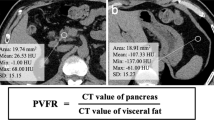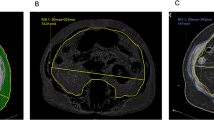Abstract
Objectives
Postoperative pancreatic fistula (POPF) is the most threatening complication after pancreatectomy. This study aimed to directly assess pancreatic fatty infiltration with preoperative computed tomography (CT) imaging and to investigate whether a preoperative analysis of patient variables, including CT characteristics and clinical factors, can predict POPF.
Methods
We enrolled 150 consecutive patients who underwent curative pancreatectomy. Radiographic factors, including pancreatic fat volume, were measured using preoperative CT imaging and the predictive factors were explored using univariate and multivariate analyses.
Results
POPF developed in 30 patients (20.0%). The ratio of pancreatic fat (RPF) ≥ 4.83% was associated with a risk of POPF, high body mass index (BMI), and obese body habitus. Patients with POPF were significantly more likely to have high BMI (≥ 25 kg/m2), obese body habitus, and an RPF ≥ 4.83% than patients without POPF. In the multivariate analysis, visceral fat area/skeletal muscle index (VFA/SMI) ≥ 1.94 (odds ratio [OR] 4.28, 95% confidence interval [CI] 1.43–12.9, p = 0.0095) was the sole independent predictive factor for POPF. For patients with a soft pancreas, VFA/SMI ≥ 1.94 (OR 5.67, 95% CI 2.05–15.7, p = 0.0008) was again the sole independent predictive factor for POPF.
Conclusion
Preoperative CT images can examine pancreatic fatty infiltration, and patients who had POPF were significantly associated with a high RPF. Among several parameters, VFA/SMI was the only independent predictive factor for clinically relevant POPF. Preoperative evaluation of these body composition variables and the pancreatic configuration could be useful for predicting POPF.

Similar content being viewed by others
References
Gooiker GA, Lemmens VE, Besselink MG, et al. Impact of centralization of pancreatic cancer surgery on resection rates and survival. Br J Surg. 2014;101(8):1000–5.
Yamada S, Nakao A, Fujii T, et al. Pancreatic cancer with paraaortic lymph node metastasis: a contraindication for radical surgery? Pancreas. 2009;38(1):e13–7.
Kimura W, Miyata H, Gotoh M, et al. A pancreaticoduodenectomy risk model derived from 8575 cases from a national single-race population (Japanese) using a web-based data entry system: the 30-day and in-hospital mortality rates for pancreaticoduodenectomy. Ann Surg. 2014;259(4):773–80.
Sui K, Okabayshi T, Iwata J, et al. Correlation between the skeletal muscle index and surgical outcomes of pancreaticoduodenectomy. Surg Today. 2018;48(5):545–51.
DeOliveira ML, Winter JM, Schafer M, et al. Assessment of complications after pancreatic surgery: A novel grading system applied to 633 patients undergoing pancreaticoduodenectomy. Ann Surg. 2006;244(6):931–7 (discussion 937–939).
Katayama H, Kurokawa Y, Nakamura K, et al. Extended Clavien-Dindo classification of surgical complications: Japan Clinical Oncology Group postoperative complications criteria. Surg Today. 2016;46(6):668–85.
Tani M, Kawai M, Hirono S, et al. Use of omentum or falciform ligament does not decrease complications after pancreaticoduodenectomy: nationwide survey of the Japanese Society of Pancreatic Surgery. Surgery. 2012;151(2):183–91.
Enestvedt CK, Diggs BS, Cassera MA, Hammill C, Hansen PD, Wolf RF. Complications nearly double the cost of care after pancreaticoduodenectomy. Am J Surg. 2012;204(3):332–8.
Fujii T, Kanda M, Nagai S, et al. Excess weight adversely influences treatment length of postoperative pancreatic fistula: a retrospective study of 900 patients. Pancreas. 2015;44(6):971–6.
Braga M, Capretti G, Pecorelli N, et al. A prognostic score to predict major complications after pancreaticoduodenectomy. Ann Surg. 2011;254(5):702–7 (discussion 707–708).
Gaujoux S, Cortes A, Couvelard A, et al. Fatty pancreas and increased body mass index are risk factors of pancreatic fistula after pancreaticoduodenectomy. Surgery. 2010;148(1):15–23.
Sandini M, Bernasconi DP, Ippolito D, et al. Preoperative computed tomography to predict and stratify the risk of severe pancreatic fistula after pancreatoduodenectomy. Medicine (Baltimore). 2015;94(31):e1152.
House MG, Fong Y, Arnaoutakis DJ, et al. Preoperative predictors for complications after pancreaticoduodenectomy: impact of BMI and body fat distribution. J Gastrointest Surg. 2008;12(2):270–8.
Roberts KJ, Karkhanis S, Pitchaimuthu M, et al. Comparison of preoperative CT-based imaging parameters to predict postoperative pancreatic fistula. Clin Radiol. 2016;71(10):986–92.
Pecorelli N, Carrara G, De Cobelli F, et al. Effect of sarcopenia and visceral obesity on mortality and pancreatic fistula following pancreatic cancer surgery. Br J Surg. 2016;103(4):434–42.
Tranchart H, Gaujoux S, Rebours V, et al. Preoperative CT scan helps to predict the occurrence of severe pancreatic fistula after pancreaticoduodenectomy. Ann Surg. 2012;256(1):139–45.
Kirihara Y, Takahashi N, Hashimoto Y, et al. Prediction of pancreatic anastomotic failure after pancreatoduodenectomy: the use of preoperative, quantitative computed tomography to measure remnant pancreatic volume and body composition. Ann Surg. 2013;257(3):512–9.
Sugimoto M, Takahashi S, Kojima M, Kobayashi T, Gotohda N, Konishi M. In patients with a soft pancreas, a thick parenchyma, a small duct, and fatty infiltration are significant risks for pancreatic fistula after pancreaticoduodenectomy. J Gastrointest Surg. 2017;21(5):846–54.
Mathur A, Pitt HA, Marine M, et al. Fatty pancreas: a factor in postoperative pancreatic fistula. Ann Surg. 2007;246(6):1058–64.
Lee SE, Jang JY, Lim CS, et al. Measurement of pancreatic fat by magnetic resonance imaging: predicting the occurrence of pancreatic fistula after pancreatoduodenectomy. Ann Surg. 2010;251(5):932–6.
Wong VW, Wong GL, Yeung DK, et al. Fatty pancreas, insulin resistance, and beta-cell function: a population study using fat-water magnetic resonance imaging. Am J Gastroenterol. 2014;109(4):589–97.
Lingvay I, Esser V, Legendre JL, et al. Noninvasive quantification of pancreatic fat in humans. J Clin Endocrinol Metab. 2009;94(10):4070–6.
Al-Haddad M, Khashab M, Zyromski N, et al. Risk factors for hyperechogenic pancreas on endoscopic ultrasound: a case-control study. Pancreas. 2009;38(6):672–5.
Fujii T, Sugimoto H, Yamada S, et al. Modified Blumgart anastomosis for pancreaticojejunostomy: technical improvement in matched historical control study. J Gastrointest Surg. 2014;18(6):1108–15.
Yamada S, Fujii T, Kawai M, et al. Splenic vein resection together with the pancreatic parenchyma versus separated resection after isolation of the parenchyma during distal pancreatectomy (COSMOS-DP trial): study protocol for a randomised controlled trial. Trials. 2018;19(1):369.
Fujii T, Yamada S, Murotani K, et al. Modified blumgart suturing technique for remnant closure after distal pancreatectomy: a propensity score-matched analysis. J Gastrointest Surg. 2016;20(2):374–84.
Bassi C, Marchegiani G, Dervenis C, et al. The 2016 update of the International Study Group (ISGPS) definition and grading of postoperative pancreatic fistula: 11 Years After. Surgery. 2017;161(3):584–91.
Callery MP, Pratt WB, Vollmer CM, Jr. Prevention and management of pancreatic fistula. J Gastrointest Surg. 2009;13(1):163–73.
Vanbrugghe C, Ronot M, Cauchy F, et al. Visceral obesity and open passive drainage increase the risk of pancreatic fistula following distal pancreatectomy. J Gastrointest Surg. 2019;23(7):1414–24.
Molinari E, Bassi C, Salvia R, et al. Amylase value in drains after pancreatic resection as predictive factor of postoperative pancreatic fistula: results of a prospective study in 137 patients. Ann Surg. 2007;246(2):281–7.
Partelli S, Tamburrino D, Crippa S, Facci E, Zardini C, Falconi M. Evaluation of a predictive model for pancreatic fistula based on amylase value in drains after pancreatic resection. Am J Surg. 2014;208(4):634–9.
Yamane H, Abe T, Amano H, et al. Visceral adipose tissue and skeletal muscle index distribution predicts severe pancreatic fistula development after pancreaticoduodenectomy. Anticancer Res. 2018;38(2):1061–6.
Rosso E, Casnedi S, Pessaux P, et al. The role of “fatty pancreas” and of BMI in the occurrence of pancreatic fistula after pancreaticoduodenectomy. J Gastrointest Surg. 2009;13(10):1845–51.
Riall TS, Reddy DM, Nealon WH, Goodwin JS. The effect of age on short-term outcomes after pancreatic resection: a population-based study. Ann Surg. 2008;248(3):459–67.
Menahem B, Mulliri A, Bazille C, et al. Body Surface Area: A new predictive factor of mortality and pancreatic fistula after pancreaticoduodenectomy: a cohort-study. Int J Surg. 2015;17:83–7.
Despres JP, Lemieux I. Abdominal obesity and metabolic syndrome. Nature. 2006;444(7121):881–7.
Tilg H, Moschen AR. Adipocytokines: mediators linking adipose tissue, inflammation and immunity. Nat Rev Immunol. 2006;6(10):772–83.
Rega G, Kaun C, Demyanets S, et al. Vascular endothelial growth factor is induced by the inflammatory cytokines interleukin-6 and oncostatin m in human adipose tissue in vitro and in murine adipose tissue in vivo. Arterioscler Thromb Vasc Biol. 2007;27(7):1587–95.
Haslam DW, James WP. Obesity. Lancet. 2005;366(9492):1197–209.
Argiles JM, Busquets S, Stemmler B, Lopez-Soriano FJ. Cachexia and sarcopenia: mechanisms and potential targets for intervention. Curr Opin Pharmacol. 2015;22:100–6.
Lutz CT, Quinn LS. Sarcopenia, obesity, and natural killer cell immune senescence in aging: altered cytokine levels as a common mechanism. Aging (Albany NY). 2012;4(8):535–46.
Gilliland TM, Villafane-Ferriol N, Shah KP, et al. Nutritional and metabolic derangements in pancreatic cancer and pancreatic resection. Nutrients. 2017;9(3):pii:E243.
Marcus RL, Addison O, Kidde JP, Dibble LE, Lastayo PC. Skeletal muscle fat infiltration: impact of age, inactivity, and exercise. J Nutr Health Aging. 2010;14(5):362–6.
Author information
Authors and Affiliations
Corresponding author
Ethics declarations
Disclosures
None.
Additional information
Publisher's Note
Springer Nature remains neutral with regard to jurisdictional claims in published maps and institutional affiliations.
Electronic supplementary material
Below is the link to the electronic supplementary material.
Rights and permissions
About this article
Cite this article
Tanaka, K., Yamada, S., Sonohara, F. et al. Pancreatic Fat and Body Composition Measurements by Computed Tomography are Associated with Pancreatic Fistula After Pancreatectomy. Ann Surg Oncol 28, 530–538 (2021). https://doi.org/10.1245/s10434-020-08581-9
Received:
Published:
Issue Date:
DOI: https://doi.org/10.1245/s10434-020-08581-9




